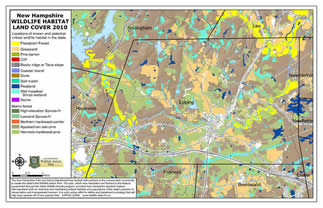 The Wildlife section of a Natural Resources Inventory (NRI) provides an opportunity to focus on important wildlife habitats and the associated species. The NRI identifies and describes important naturally-occurring resources in an area, provides the basis for land conservation planning, allows natural resources information to be included in local planning and zoning, and provides communities with a strong foundation for informed decision-making. The NH Wildlife Action Plan is a valuable source of information about wildlife and habitats that can be easily incorporated into an NRI.
The Wildlife section of a Natural Resources Inventory (NRI) provides an opportunity to focus on important wildlife habitats and the associated species. The NRI identifies and describes important naturally-occurring resources in an area, provides the basis for land conservation planning, allows natural resources information to be included in local planning and zoning, and provides communities with a strong foundation for informed decision-making. The NH Wildlife Action Plan is a valuable source of information about wildlife and habitats that can be easily incorporated into an NRI.
At the minimum, your community should have the basic set of NRI maps. The Table of Basic NRI Maps provides a list of these maps and their data requirements.
Sample NRI maps for Epping, NH:
- Wildlife Habitat Map
- Highest Ranked Habitat Map
- Aerial Photo Map
- Conservation Lands
- Water Resources and Wetlands
- Unfragmented Blocks
- Digitized Tax Map
- Regional Conservation Plan - NH Coastal Conservation Plan
The steps outlined below can help you incorporate the latest wildlife research and data into your NRI.
1. Obtain Wildlife Action Plan maps for your community or region
- Town maps on NH Fish & Game's web site Print small scale maps for your town (two sizes/formats).
- GRANITView Mapper - use this to create 8.5 x 11 size wildlife maps and other NRI maps.
- GRANIT - NH's on-line GIS clearinghouse for GIS users to obtain the wildlife data (or contact NH Fish and Game's Wildlife Division for a CD with this data).
- Large scale (poster size) maps - can be obtained through your GIS provider or Regional Planning Commission
2. Review the Wildlife Action Plan maps for your community or region
- Wildlife Habitat Land Cover Map - Review this map to identify and list the critical wildlife habitats occurring in your area. Note which habitats that are uncommon in your area and in surrounding areas.
- Highest Ranked Wildlife Habitats map use this map to identify highest ranked habitats in the state (pink), in the region (green) and supporting landscapes (orange) that occur in your town.
- Learn how to use these maps and associated data and incorporate them into your NRI.
3. Review the Wildlife Action Plan Chapters and Appendices
- Learn how to use the information in Appendices A, B, D and Chapters 4 and 5 (critical habitats and species) in the NH Wildlife Action Plan and incorporate it into your NRI
- Habitat Stewardship Brochures series – these provide very user-friendly information about critical habitats, the species likely to occur there and guidelines for managing those habitats.
4. Review Rare Plants and Wildlife Information
- Rare Plants, Rare Animals, and Exemplary Natural Communities in New Hampshire Towns - published by the NH Natural Heritage Bureau. Select your town's page for a list of rare plants and wildlife species observed in your community (some are historical records with no recent data) and include this information in your NRI.
5. Compile wildlife information for the NRI report
- Community Stories provides examples of community NRIs that include wildlife sections based on Wildlife Action Plan data. Review these reports to get ideas for writing up the Wildlife section of your NRI.
6. Conduct Public Outreach to Publicize the NRI
- Public Outreach and Wildlife Habitat shows how you can build public support for your NRI. Involve the public early on and provide opportunities for public input. Keep local residents and decision makers informed about progress with your NRI through press releases, events, etc.
7. Use the NRI to develop a Conservation Plan
- Conservation Planning for Wildlife - Completing the NRI is the first step in conservation planning. Learn how to start working on your Conservation Plan to protect priority habitats.
- Land Conservation to Protect Wildlife Habitat provides information on land conservation options and working with landowners interested in conserving their land.
- Regulations to Protect Wildlife Habitat provides details on how you can use the information in your NRI to develop or enhance regulations to protect wildlife habitats.
- Manage and Restore Wildlife Habitats shows how habitats can be restored or enhanced.
Additional Resources for the Wildlife section of your NRI:
- Sample outline for NRI, including Wildlife Chapter
- Helpful Websites for Communities Conducting Natural Resources Inventories.
- Wildlife Action Plan Critical Habitats and Possible Associated Species Master List
- Natural Resources Inventories: A Guide for NH Communities and Conservation groups (2001) (Large PDF Download Alert - this file is 29MB and will take some time to dowload, even with a high-speed internet connection)